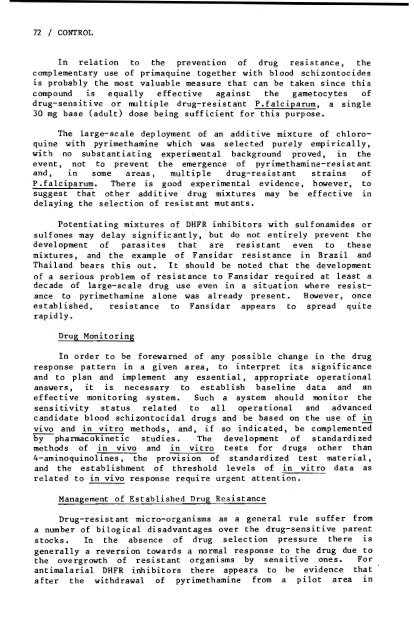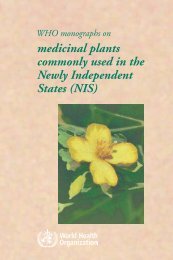Drug-Resistant Malaria - libdoc.who.int - World Health Organization
Drug-Resistant Malaria - libdoc.who.int - World Health Organization
Drug-Resistant Malaria - libdoc.who.int - World Health Organization
Create successful ePaper yourself
Turn your PDF publications into a flip-book with our unique Google optimized e-Paper software.
72 / CONTROL<br />
In relation to the prevention of drug resistance, the<br />
complementary use of primaquine together with blood schizontocides<br />
is probably the most valuable measure that can be taken since this<br />
compound is equally effective against the gametocytes of<br />
drug-sensitive or multiple drug-resistant P.falciparum, a single<br />
30 mg base (adult) dose being sufficient for this purpose.<br />
The large-scale deployment of an additive mixture of chloroquine<br />
with pyrimethamine which was selected purely empirically,<br />
with no substantiating experimental background proved, in the<br />
event, not to prevent the emergence of pyrimethamine-resistant<br />
and, in some areas, multiple drug-resistant strains of<br />
P .falciparum. There is good experimental evidence, however, to<br />
suggest that other additive drug mixtures may be effective ~n<br />
delaying the selection of resistant mutants.<br />
Potentiating mixtures of DHFR inhibitors with sulfonamides or<br />
sulfones may delay significantly, but do not entirely prevent the<br />
development of parasites that are resistant even to these<br />
mixtures, and the example of Fansidar resistance in Brazil and<br />
Thailand bears this out. It should be noted that the development<br />
of a serious problem of resistance to Fansidar required at least a<br />
decade of large-scale drug use even in a situation where resistance<br />
to pyrimethamine alone was already present. However, once<br />
established, resistance to Fansidar appears to spread quite<br />
rapidly.<br />
<strong>Drug</strong> Monitoring<br />
In order to be forewarned of any possible change in the drug<br />
response pattern in a given area, to <strong>int</strong>erpret its significance<br />
and to plan and implement any essential, appropriate operational<br />
answers, it is necessary to establish baseline data and an<br />
effective monitoring system. Such a system should monitor the<br />
sensitivity status related to all operational and advanced<br />
candidate blood schizontocidal drugs and be based on the use of in<br />
vivo and in vitro methods, and, if so indicated, be complemented<br />
~pharmacokinetic studies. The development of standardized<br />
methods of ~n vivo and ~n vitro tests for drugs other than<br />
4-aminoquinolines, the provision of standardized test material,<br />
and the establishment of threshold levels of in vitro data as<br />
related to in vivo response require urgent attention.<br />
Management of Established <strong>Drug</strong> Resistance<br />
<strong>Drug</strong>-resistant micro-organisms as a general rule suffer from<br />
a number of bilogical disadvantages over the drug-sensitive parent<br />
stocks. In the absence of drug selection pressure there is<br />
generally a reversion towards a normal response to the drug due to<br />
the overgrowth of resistant organisms by sensitive ones. For<br />
antimalarial DHFR inhibitors there appears to be evidence that<br />
after the withdrawal of pyrimethamine from a pilot area in
















